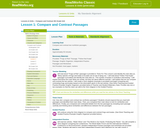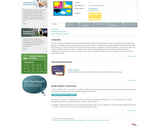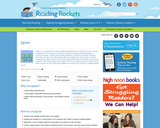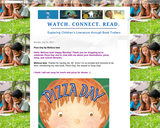
Please Remix this template for your purposes.
- Subject:
- Environmental Literacy and Sustainability
- Material Type:
- Other
- Primary Source
- Author:
- The genius group from Madison Wisconsin
- Date Added:
- 04/06/2024

Please Remix this template for your purposes.

This is a complete lesson plan with passages and resources provided. This includes standards addressed as well as ideas for stuggling learner. The lesson focuses on comparing and contrasting two nonfiction texts.

In order to fully comprehend reading materials, students need to understand the cause-and-effect relationships that appear in a variety of fiction and nonfiction texts. In this lesson, students learn cause-and-effect relationships through the sharing of a variety of Laura Joffe Numeroff picture books in a Reader's Workshop format. Using online tools or a printed template, students create an original comic strip via the writing prompt, "If you take a (third) grader to." Students use various kinds of art to illustrate their strip and publish and present their completed piece to peers in a read-aloud format.

Module 1A focuses on building community by making connections between visual imagery, oral accounts, poetry and written texts of various cultures with a focus on the Haudenosaunee (Iroquois) culture. Students will determine a central idea and demonstrate how gathering information from a variety of sources can help us understand a central idea more fully.| Module 1 also reinforces reading fluency, close text analysis, explanatory paragraph writing, and presenting to peers. The module reinforces the fact that Native Americans—specifically the Iroquois (Haudenosaunee, People of the Longhouse) —were early inhabitants of the New York region and state, and continue to contribute to the region’s history.
Find the rest of the EngageNY ELA resources at https://archive.org/details/engageny-ela-archive .

In this eight-week module, students explore animal defense mechanisms. They build proficiency in writing an informative piece, examining the defense mechanisms of one specific animal about which they build expertise. Students also build proficiency in writing a narrative piece about this animal. In Unit 1, students build background knowledge on general animal defenses through close readings of several informational texts. Students will read closely to practice drawing inferences as they begin their research and use a science journal to make observations and synthesize information. Students will continue to use the science journal, using the millipede as a whole class model. They begin to research an expert animal in preparation to write about this animal in Units 2 and 3, again using the science journal. In Unit 2, students will continue to build expertise about their animal and its defense mechanisms, writing the first part of the final performance task—an informative piece describing their animal, the threats to its survival, and how it is equipped to deal with them. With their new knowledge about animal defenses from Unit 1, students will read informational texts closely, using the same science journal to synthesize information about their animal. Unit 3 allows students to apply their research from Units 1 and 2 to write a narrative piece about their animal that incorporates their research. This narrative will take the format of a choose-your-own-adventure. For their performance task, students will plan, draft, and revise the introduction and one choice ending of the narrative with the support of both peer and teacher feedback. The second choice ending will be planned, written, and revised on-demand for the end of unit assessment.
Find the rest of the EngageNY ELA resources at https://archive.org/details/engageny-ela-archive .

Paraphrasing helps students make connections with prior knowledge, demonstrate comprehension, and remember what they have read. Through careful explanation and thorough modeling by the teacher in this lesson, students learn to use paraphrasing to monitor their comprehension and acquire new information. They also realize that if they cannot paraphrase after reading, they need to go back and reread to clarify information. In pairs, students engage in guided practice so that they can learn to use the strategy independently. Students will need prompting and encouragement to use this strategy after the initial instruction is completed. The lesson can be extended to help students prepare to write reports about particular topics.

Jigsaw is a reading comprehension strategy encouraging cooperative learning among students.

John Schumacher (aka Mr. Schu) is a blogger, a part-time lecturer at Rutgers University, and the Ambassador of School Libraries for Scholastic Book Fairs®. You could say every day is a giant book party for this teacher-librarian! In fact, Library Journal named him "The Xtreme Librarian" for the high level of exertion – along with some gears and stunts – he uses to get kids reading, and Instructor Magazinenamed him a Cool Teacher for redefining what it means to be a teacher-librarian.
This resource is a link to his Blog. The Blog hosts children's book trailers he has created. He explains "how" he created them.

This is a lesson for tropical rainforests that fits best for third- through fifth-grade students. There are multiple reading and writing strategies implemented within the lesson. Throughout the lessons, there will be opportunities to build upon prior knowledge, write, draw, and listen to sound effects of the rainforest. Students will use graphic organizers and websites to aid in the understanding and learning of rainforests. There are also extension lessons for students to create a list of questions in small groups to research. Throughout these lessons the students will be exposed to multiple media sources.Â

Not afraid to stand up for what he believed in, this member of the Red Cliff Band of Lake Superior Chippewa dedicated himself to protecting the rights and lands of First Nations people in Wisconsin.
Resources available for exploring this story include:
- A short animated video with captions and transcripts in English and Spanish
- A short biography book accessible as a slide deck, with per-page audio for listening along, and maps of key locations in the story
- Questions that can be used for conversation, reflection, and connection with the story
- A historical image gallery full of primary and secondary sources to explore
- A guide for activating the media with learners that includes story stats, extension activity ideas, and standards supported
This story is part of Wisconsin Biographies, a collection of educational media resources for grades 3-6. Explore the full collection at pbswisconsineducation.org/biographies.

Your student will gather clues to infer the location of each scenario in this worksheet. It's perfect for practicing inference for 4th and 5th grade Common Core Standards for Reading Literature or Reading Informational Text. Other grades may also find it helpful.